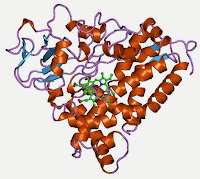Oxygen-Atom Transfer: Cytochrome P450
 |
| Cytochrome P450 from Pseudomonas putida |
Furthermore, this such control controlled oxidation of unreactive hydrocarbon under mild conditions is different in synthetic chemistry.
The active site of P450 is Fe-porphyrin with axial thiolate from cysteine and water ligands as shown below.
 |
| The active site of cytochrome P450 |
P450 is a protein family of this oxygen-atom transfer agent with typical molecular weight of 45 000 - 50 000 Daltons but all P450 derivatives have the same active site. In resting state, Fe is in low-spin Fe(III) form and it is shown by characteristic EPR spectrum. Similarly with haemoglobin, low-spin Fe(III) ion fits in plane of porphyrin.
The mechanism of action of cytochrome P450 in oxidising simple substrate RH to ROH can be described in a cycle consisting of 6 steps.
 |
| Catalytic cycle of P450 |
(i) Binding of substrate occurs into hydrophobic cavity and it may involve hydrogen bonding interaction between substrate to side chains or aromatic stacking. The loss of water ligand when RH binds generates high-spin Fe(III) with Fe out-of-plane towards axial cysteine. Then, (ii) one electron reduction from FADH2 (biological reductant) generates high-spin Fe(II) ready for O2 binding. (iii) O2 binding generates low-spin Fe(III) superoxide. The superoxide ion is stabilised by hydrogen bonding interaction from nearby amino acids. (iv) second electron reduction generates very reactive short-lived Fe(III) peroxide. The second electron is transferred from either cytochrome P450 reductase, ferredoxins or cytochrome b5.(v) Fe(III)-peroxide adds two H+ and liberates H2O, cleaving O-O bond and leaving Fe(IV)/O unit which is the key reactive species.
However, it is often described as Fe(IV)-O but oxidation staes in this are ambigous due to several reasons. Fe(IV)-O could be written as Fe(V)=O and can put one oxidising equivalent on porphyrin because the aromatic sytem with a charge of 2- can be readily oxidised from P2- to P.-.
From a simple model from the reaction Fe(III)-porphyrin with PhIO (oxo-transfer agent) generates species whose properties are consistent with formulation Fe(IV)=O.
This formulation of Fe(IV)=O is supported by short Fe-O distance which is consistent with Fe=O. Besides that, 1H-NMR signals shift up to 70 ppm which implies paramagnetism of porphyrin ring and the magnetic behaviour is consistent with antiferromagnetic coupling arising from Fe(IV) and P.-. Lastly, it also performs the same type of oxidation reactions as P450.
Finally, (vi) transfer of mono-oxygen radical from Fe(IV)-O to substrate RH via homolytic cleavage and O atom is inserted.
There are 2 pieces of evidence for this mechanism which are some chiral substrate partially racemise which suggesting non-chiral intermediate and large kinetic isotope effect (much slower with C-D bond relative to C-H bond) which implies the rate limiting step is CH dissociation. The ROH is released and water is coordinated back to regenerate the resting state of P450.
In the research to understand the behaviour of P450, a complex model can be used and there are two examples of P450 complex model.
This complex serves as structural model for high-spin Fe(II) form and it uses pendant thiolate to mimic axial cysteine. The second example below serves as functional model.
The product of Fe(TPP)Cl and PhIO is unstable Fe(IV)=O species that do the same oxidation chemistry as P450.






Comments